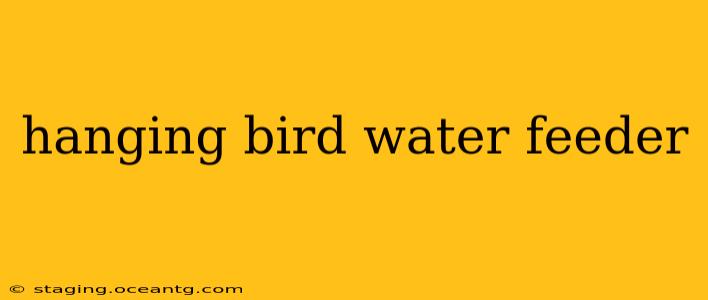Providing a reliable water source for birds, especially during hot weather, is crucial for their health and survival. A hanging bird water feeder offers a convenient and safe way to do this, keeping the water clean and accessible. This guide will explore everything you need to know about choosing, installing, and maintaining a hanging bird water feeder, answering common questions along the way.
What are the benefits of using a hanging bird water feeder?
Hanging bird water feeders offer several advantages over other water sources:
-
Accessibility: They are easily accessible to birds of varying sizes, unlike shallow dishes that might be difficult for smaller birds to navigate. The design often incorporates perches, making it easier for birds to drink and bathe.
-
Cleanliness: Elevated placement reduces contamination from ground debris and droppings. Many designs incorporate easy-to-clean features.
-
Safety: Hanging feeders keep water away from predators and minimize the risk of drowning, particularly for smaller birds.
-
Space Saving: They don't take up valuable ground space in your garden.
-
Variety: Numerous designs and materials are available, catering to different bird species and aesthetic preferences.
What types of hanging bird water feeders are available?
There's a wide variety of hanging bird water feeders available, each with its own pros and cons:
-
Dish-style feeders: These mimic shallow puddles and are good for bathing. Choose one with a gentle slope to prevent drowning.
-
Bottle-style feeders: These often feature a reservoir at the top and a drip system, dispensing water steadily. They are ideal for areas with limited space.
-
Fountain-style feeders: These feature a small fountain or circulating water, keeping the water fresh and aerated, attracting more birds. They tend to be more expensive but provide excellent functionality.
How do I choose the right hanging bird water feeder?
Consider these factors when selecting a hanging bird water feeder:
-
Size and capacity: Choose a size appropriate for the number of birds you expect to visit. Larger feeders hold more water, reducing the frequency of refills.
-
Material: Stainless steel and plastic are common materials. Stainless steel is durable and easy to clean, while plastic is lighter and more affordable.
-
Ease of cleaning: Regular cleaning is essential. Opt for a feeder with a design that allows for easy access and thorough cleaning.
-
Bird species: Some feeders are designed to accommodate specific bird sizes and preferences.
-
Durability: Look for a feeder constructed from sturdy materials that can withstand various weather conditions.
How often should I clean my hanging bird water feeder?
You should clean your bird water feeder at least once a week, or more frequently during hot weather. Standing water can quickly become a breeding ground for bacteria and mosquitoes. Cleaning should involve thoroughly scrubbing the feeder with a mild soap solution and rinsing it thoroughly with clean water before refilling.
What is the best way to install a hanging bird water feeder?
Ideally, hang your feeder in a location that is:
- Visible to birds: Place it in an area where birds can easily spot it.
- Shaded: Protect the water from direct sunlight, which can cause it to overheat and evaporate quickly.
- Away from predators: Avoid placing it near bushes or structures where cats or other predators might lurk.
- Accessible for cleaning: Choose a location that allows easy access for regular cleaning and refilling.
Can I use tap water in my hanging bird water feeder?
It's generally safe to use tap water, but allow it to sit for a while to let chlorine dissipate. Consider adding a small amount of diluted bleach (one part bleach to ten parts water) to help sanitize the water (ensure you rinse thoroughly before adding fresh water).
How do I prevent my hanging bird water feeder from freezing in winter?
In freezing temperatures, the water in your feeder may freeze. To prevent this, consider using a heated bird bath or placing the feeder in a location sheltered from the wind. You can also try adding a bird bath heater to the water.
By following these guidelines, you can provide birds with a safe and reliable source of water throughout the year, contributing to their well-being and enriching your outdoor space. Remember to always prioritize hygiene and safety when choosing and maintaining your hanging bird water feeder.
